A Brief History of Photography
|
Camera Obscura, 16th century |
Table-Top Camera Obscura, 17-18th centuries |
A Brief History of Photography
|
Camera Obscura, 16th century |
Table-Top Camera Obscura, 17-18th centuries |
We owe the name "Photography" to Sir John Herschel, who first used the term in 1839, the year the photographic process became public. The word is derived from the Greek words for light and writing. The innovations which would lead to the development of photography existed long before the first photograph. The camera obscura (Latin,literally translating to "dark room") had been in existence for at least four hundred years, but its use was limited to its purpose as an aid to drawing. It was discovered that if a room was completely darkened, with a single hole in one wall, an inverted image would be seen on the opposite wall. A person inside of the room could then trace this image, which was upside-down (similating the way that images actually enter our eyes). The earliest record of the uses of a camera obscura can be found in the writings of Leonardo da Vinci (1452-1519), who may have used it as an aid to understanding perspective. In the 17th and 18th centuries, a table-top model was developed. By adding a focused lens and a mirror, it was possible for a person outside of the box to trace the image which was reflected through it.
|
Nicephore Niepce, World's First Photograph 1827 |
Louis Jacques Mande Daguerre, Paris Boulevard 1839 |
It was a French man, Nicephore NiŽpce (pronounced Nee-ps) who produced the first photograph in June/July 1827. By using chemicals on a metal plate, placed inside of a camera obscura, he was able to record an obscure image of the view outside of his window. He called his process "heliography" (after the Greek "of the sun"). The image is difficult to decipher, but there is a building on the left, a tree, and a barn immediately in front. The exposure lasted eight hours, so the sun had time to move from east to west, appearing to shine on both sides of the building. Another problem is that he had difficulty "fixing" the image so that it would not continue to darken when exposed to light.Daguerre (pronounced Dagair) is the most famous of several people who invented more successful and commercially applicable forms of photography. He regularly used a camera obscura as an aid to painting in perspective, and this had led him to seek to freeze the image. In 1826 he learned of the work of Nicephore NiŽpce, and in January of 1829 signed up a partnership with him. The partnership was a short one since NiŽpce died in 1833, but Daguerre continued to experiment. He was able to reduce the exposure time to thirty minutes, and in 1837 he discovered a chemical process which would permanently to fix the image. This new process he called a Daguerreotype. Drawbacks at this time included the fact that the length of the exposure time ruled out portraiture; the image was laterally reversed (as one sees oneself in a mirror); and that the image was very fragile. Another drawback was that it was a "once only" system (since it was fixed to metal). Soon, exposure times were reduced to a matter of seconds, and portraiture became a commercially viable purpose for the new technology. It would be up to George Eastman to introduce flexible film in 1884, allowing multiple images to be produced on light-sensitized paper. Four years later he introduced the box camera, and photography could now reach a much greater number of people. With his slogan "You press the button, we do the rest" he brought photography to the masses.
Early
Daguerrotypes
|
Daguerrotype of Couple Holding Daguerrotype (Unknown Artist) 1850 |
Kneeling Woman, daguerrotype 1850 |
Couple Holding a Daguerrotype is one of my favorite historical photographs because of its unique commentary on the value of photographs as a record of the real world. There is a sadness apparent in the couple's faces which tell me that the persons in the photograph are either deceased or separated from a long distance. Daguerre's invention made it possible for anyone of moderate means to have a portrait created, and photographers profitted from traveling to towns across the United States. In addition, any large town had dozens of photographic studios available for people to travel to.
Most people embraced this new technology with great enthusiasm. A few religious zealots, however, claimed that it was the work of the devil. Many artists who had trained for years in the techniques of portrait painting were also to find it a threat to their livelihood. Some painters dubbed the new invention "the foe-to-graphic art." A number of artists turned to photography for their livelihood, while others cashed in on the fact that the images were in monochrome, and began coloring them in. Some painters also used photography to assist them in painting (some of these artists were Gauguin, CŹzanne, Courbet, Lautrec, Delacroix and Degas). Photography would eventually change the purpose of painting from one which focused on outward facts of reality to more emphasis on personal vision.
|
Matthew Brady, Abraham Lincoln |
Emily Dickinson at 17 (Unknown Artist) 1847 |
Julia Margaret Cameron, Echo 1868 |
Anyone who was famous after 1839 had their likeness captured for future generations. Abraham Lincoln credited the success of his presidential election to two things: his widely known speech (the Gettysburgh Address) and his photograph, which was widely distributed. In addition to Lincoln's portrait, Matthew Brady is also famous for his images of Mark Twain, Walt Whitman, and Edgar Allen Poe. Julia Margaret Cameron was also well known for her photographs of famous men (Charles Darwin among them) as well as for her images of "fair women", She preferred a soft-focus effect, which have a poetic, haunting quality.
|
Civil War Field Camera |
Timothy O'Sullivan, Harvest of Death (Gettysburgh) |
In addition to portraits of famous men, Matthew Brady is known for his portraits of Civil War generals and for his images of vast fields littered with the corpses in the aftermath of battle. This was the first time that the destruction of war was captured on film, and would change the way we look at war forever. Brady is sometimes thought of as the century's most important photographer and the man who invented photojournalism. He also took credit for hundreds of photographs which were done by his employees, the most famous of these artists was Timothy O'Sullivan, who is believed to have moved corpses to attain more successful compositions.
Pioneers of Motion Photography
|
|
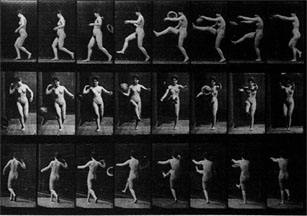 |
Pioneers of motion photography include Eadweard Muybridge and Thomas Eakins (more famous as a realist painter). Muybridge's main claim to fame was his exhaustive study of movement of both animals and humans. The story goes that an owner of race horses bet a friend that when a horse gallops all four feet are, at one point, off the ground simultaneously. He hired Muybridge to prove the claim was true. Using twenty four cameras, Muybridge was able to photograph a horse galloping, each triggered off by the breaking of a trip-wire on the course. In the 2nd and 3rd frame of the photograph, you can see that the horse-owner was right. In 1884, the University of Pennsylvania commissioned Muybridge to make a further study of animal and human locomotion. The report, "Animal Locomotion" was published three years later and still ranks as the most detailed study in this area. It contains more than twenty thousand images. In 1878 an article in Scientific American published some of Muybridge's sequences, and suggested that readers might like to cut the pictures out and place them in a "zoetrope" so that the illusion of movement might be re-created. Intrigued by this, Muybridge experimented further, and in time invented the zoopraxiscope, an instrument which in turn paved the way for cine photography. Eakins was also influential in this area, with his invention of a camera which could record several sequential exposures of a moving person in a single photograph.
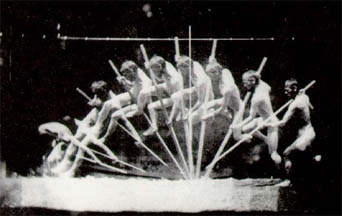 |
Stereo Photographs
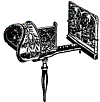 |
Stereograph (unknown artist) |
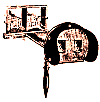 |
One way that a photograph differs from the way that we perceive things in reality is that our eyes see in stereoscopic vision, whereas a photograph flattens all sense of three-dimensional depth. To compensate for this difference, the stereograph was invented. A camera would take 2 simultaneous images, and the developed image could be viewed by a stereoscope, which converged the 2 images into one 3-dimensional image. Viewing these images continued to be a very popular past-time until the invention of television.
Photography As A Document of the Times
|
Lewis Hine, Child in Spinning Mill 1908 |
Lewis Hine, Boy in Glass Factory 1908 |
|
Votes For Women (Unknown Photographer) |
Flying Black Hats: Biplane Tennis 1910 |
|
Lewis Hine, Building of the Empire 1931 |
The Hindenburg |
|
Margaret Bourke-White, No Turning Away (Concentration Camp) 1945 |
Dorothea Lange, Migrant Mother 1931 |
|
Sue Hartke, Civil Rights Activists 1968 |
Stuart Franklin, Tianamen Square 1989 |
Photography
in Science
|
Harold Edgerton, Milk Splashed on a Saucer 1938 |
Photo of the Earth from the Space Shuttle "Discovery"
|
Controversial Subjects
|
Sally Mann: Emmet, Jesse, and Virginia 1987 Mann's photographs of her children posed nude or semi-nude has created controversy about whether they are pictures of childhood innocence or child pornography. |
Robert Mapplethorpe Famous for images of homo-eroticism and inter-racial images, Mapplethorpe's shows have created conflicts about the funding of the National Endowment for the Arts |
Basic
Mechanics of the Camera
Aperture: Controller of Light
 |
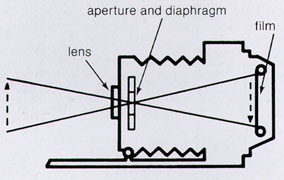 |
The lens focuses the light entering a camera to create a sharp image. The aperture setting (also known as f-stop) then controls the quantity of light which enters the camera. A small aperture (large f-stop) lets in a smaller amount of light than a larger aperture (small f-stop). Many cameras today automatically read the light and adjust the aperture for you so that you don't need to be concerned with this. However, having the option of controlling the aperture (and shutter speed) gives the artist more control of the image, allowing for manipulation of effects.
Depth of Field
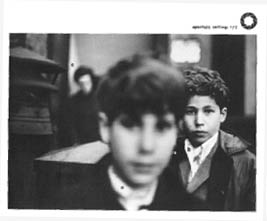 |
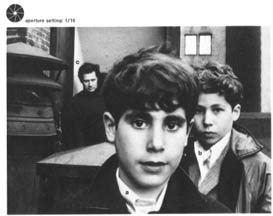 |
One variable which is affected by the aperture is the depth of field within a photograph. Using a large aperture allows you to focus on a smaller depth of field than a smaller aperture setting. There are times that the artist prefers a selective focus, and other times when it is more advantageous for everything to be in focus. When altering the aperture, the shutter speed also needs to be taken into consideration. A larger amount of light entering the camera necessitates a shorter shutter speed and a small opening requires a longer shutter speed for the same amount of light.
Shutter Speed
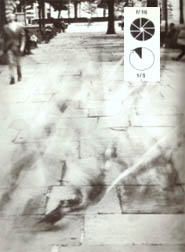 |
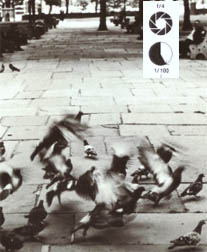 |
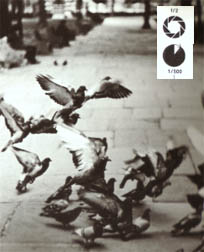 |
The subject of a photograph is also a consideration when selecting a shutter speed. Because the shutter speed determines the length of time in which light enters the camera, anything which is in movement requires a fast setting (unless a blur is the effect you are trying to achieve). Again, if the shutter speed is altered, the aperture needs to be adjusted as well. Do you notice that the depth of field has also been affected in the third photograph, where the aperture setting is large?
Stilled Motion
(fast shutter speed)
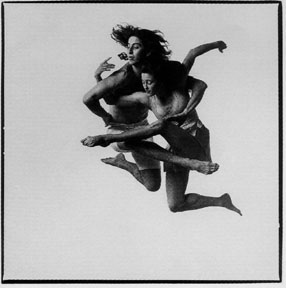 |
Barbara Morgan, Martha Graham 1940 |
Slow Shutter Speed
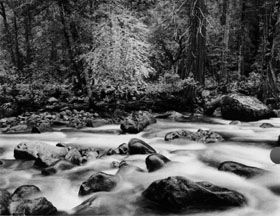
It is obvious that this photograph of a running stream was created using a slow shutter speed because of the cloudy effect of the moving water. Ansel Adams also used a long exposure when he photographed the moon illuminating a darkened cove. Edward Weston also achieved unusual effects using natural light and a long exposure to emphasize the tonal values of his famous Pepper. The pepper itself is an unusual specimen, and he increased the drama of the image by using a wide-angle lens.
|
Ansel Adams, Moon and Half Dome 1960 |
Edward Weston, Pepper |
Unusual Effects & Altered Techniques
|
Man Ray, Glass Tears |
Man Ray, Solarization 1929 |
The surrealist artist, Man Ray, is known for his many provocative images in photography as well as for found-object sculptures. His approach to photography was always to challenge the traditional ways of seeing. His extreme close-up of an eye with perfectly round tears is an arresting image. He is also known for his experiments with a darkroom process called solarization, in which the image is treated with special chemicals and exposed to light before it is thoroughly developed.
|
Jerry Uelsmann, Headrock |
Jerry Uelsmann, Flying Girl |
Jerry Uelsmann is one of the more famous artists working with a technique of combining several different negatives for each print. Instead of manipulating prints by cutting and pasting after development, the images are altered in the dark-room. He uses several enlargers, which each have a different negative placed under the lamp. The photographic paper is sequentially moved from one enlarger to the next, "burning in" and "dodging out" the light wherever it needs to be manipulated. The paper is then processed to create a one-of-a-kind (irreproducable) print.
|
Eric Renner, Stretch Marilyn (pinhole photo), 1997 |
Eakin, Alien (pinhole photo) |
Another technique for altering the appearance of photographs is to use a "pin-hole" camera. Did you know that you can make a camera out of practically anything? The principle goes back to the early days of photography, based on the fact that all that is needed is a tiny hole in a light-tight container. If the container happens to have rounded edges, it further distorts the appearance of the image. Here are a few of my favorite samples from a site I discovered about pinhole photography.

Roth, Untitled (Cookie Tin Pinhole Photograph) 1996
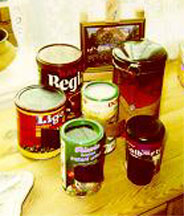 |
Creating Pinhole Photographs: Pinhole photographs can be made by altering practically any light-tight container. Coffee cans are probably the most often used, but people have used everything from hatboxes to cookie tins, shoe boxes to kitchen appliances. The most important thing is that all light is sealed from entering the container. A tiny hole is inserted in a thin piece of metal, then taped into a larger hole in the container (to prick a hole directly into the container will usually not give as sharp an image, unless the container is made of metal). Sheet film is placed directly in the container, on the wall opposite the hole (naturally, you will need to do this in a dark closet). You will need to experiment with exposure times. It can take anywhere from a few seconds to a few hours, depending on the hole size and available light. |
Other
Unique Cameras
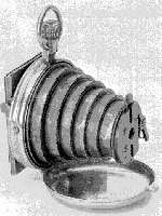 |
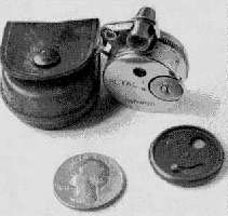 |
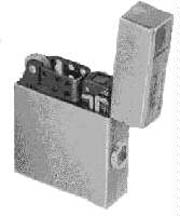 |
Here are just a few examples of miniature cameras ("spy cameras") which have been marketed in the past. The one in the middle, the" petalcam" is slightly larger than a quarter, and recorded in the Guinness Book of World records as the smallest camera created . This record has been beat, of course, since the invention of cameras that can be inserted into your bloodstream for medical purposes.
Office Machine Art
|
David Root, Ballerina 1978 |
Locurto and Outcult, |
Artist David Root created this very
interesting collage of a ballerina by directly laying her body parts on a
color xerox machine. This 7x7 foot mosaic was created using 60 separate color
copies. In corners of the composition, he xeroxed the gauze material that
makes up her costume, and there are also copies of postcard reproductions
from the ballerina paintings of Edgar Degas. A married couple scan images
of their own bodies by standing above or getting under a suspended computer
scanner. The distortion creates some very unique effects. Can you think of
more creative uses for common office machinery?